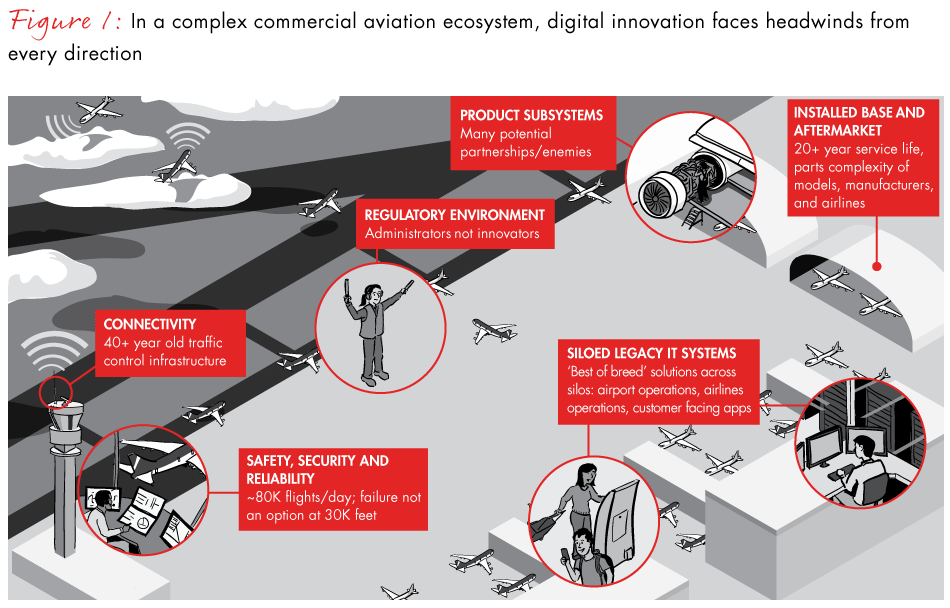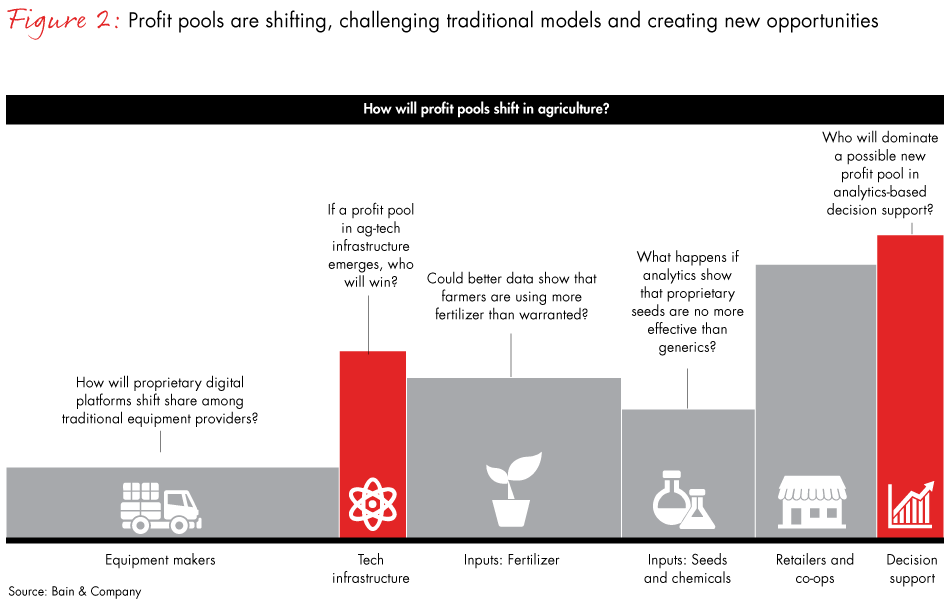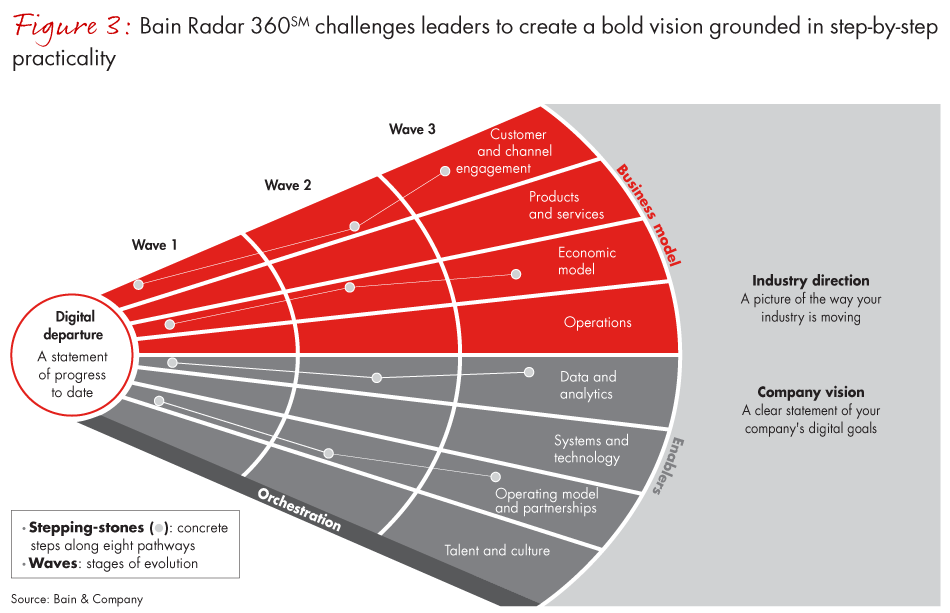Brief

It’s easy to see why so many view companies like Uber, Amazon and Google as the business models of the future. They’ve redefined their industries. They’ve rewired the customer experience. They’re not afraid to fail fast, learn from mistakes and make the changes necessary to stay well ahead of the market.
None of this is news to leaders of industrial and other business-to-business (B2B) companies. But these executives also know full well that what works in the consumer realm doesn’t always translate in a B2B context. Failing fast? That’s problematic in industries such as chemical processing or offshore drilling, where the smallest mistake can trigger epic disaster. Moving quickly? We’ll get back to you when our channel partners get back to us. Redefining the industry? Easier said than done in a business like aviation, where many stakeholders operate in a complex, interdependent ecosystem.
The truth is B2B is different than business-to-consumer (B2C) when it comes to digital strategy, and it requires a different approach. There are many lessons to be learned from digital innovators like Amazon, and the opportunities are very real. But simple comparisons to what works for these digital standouts aren’t always useful in an industrial setting and often come off as naive or impractical, feeding the notion that digital is more hype than reality. This gets in the way of deciding how digital can, in fact, transform important parts of a business and makes it hard to create alignment around the right path forward.
Ryan Morrissey, who leads Bain’s digital efforts in the Industrial Goods & Services practice, shares two things B2B companies should do to shift toward an effective digital strategy.
Doers vs. dreamers
When it comes to strategy development, most leadership teams have both doers and dreamers. Doers are focused on the here and now. They want to cut through the digital hype and direct the company’s energy toward implementing practical digital initiatives. The dreamers tend to focus on the long term. They want to define the full set of ways digital could either evaporate the company’s profit pools or create new opportunities to become the disrupter. Both perspectives are critical because both are valid. Yet when these two groups are left in opposition, the tension can be paralyzing.
An effective strategy-development process resolves these conflicts by striking a balance between the doer and dreamer perspectives. It should blend a practical set of near-term, high-impact initiatives with a bold vision for how the pace of digital innovation is likely to reshape the industry over time.
Getting it right starts with a few key assumptions about the opportunities and constraints of devising strategy in a B2B world.
Today is measurably different from prior eras. Although there’s plenty of froth in the marketplace around digital technology, the confluence of smart devices, low-cost networks and massively powerful cloud-based computing has simply changed the calculus of running a business at every level of the organization. In the past five years alone, data generation has soared 40-fold amid a 4x increase in connected devices. Pipe dreams such as autonomous vehicles are suddenly becoming reality. The line is blurring between products and services. Customers who have grown accustomed to flawless online experiences in their personal lives expect nothing less in their business relationships. In such an environment, it is not only possible to dream big but dangerous not to.
The direction of disruption is knowable. As dynamic as the current period is, it doesn’t have to be disorienting. The contours of disruption are very often discernible long before the actual disruption occurs. Autonomous vehicles, smart buildings and the connected farm—all were visible and widely discussed decades before they began to emerge as realities. Leaders need to understand how such digital trends could affect the industry and use this knowledge to form a point of view on the future—one that can be incorporated into the company’s long-term strategic vision. The harder work is figuring out how the company will get there or how to adjust when the environment changes. But defining the direction of disruption removes one important variable from the digital equation.
Ecosystems make all the difference. B2B companies operate in complex business ecosystems. Think about the aviation sector (see Figure 1). Everyone in the industry can agree on what the digital future should look like: It is a model of efficiency with state-of-the-art air traffic control systems; modern, fuel-efficient aircraft; integrated IT systems; and drastically improved customer experiences. But a digital strategy that ignores the facts on the ground would be impractical. Many issues limit the pace and scope of innovation, including regulation, expensive aircraft with long life cycles, aging technical infrastructure and very real concerns about the impact of digital innovation on security. Other industrial sectors face similar constraints as companies try to resolve questions around which platforms will become standard, who owns precious data and how it will be shared. These factors offer some protection against disruption as they discourage new entrants. But they also present executives with hard choices about what a workable strategy looks like and how they can make real progress against systemic complexity.


Profit pools will shift. Though it may take time, digital innovation will eventually change who is making the most money and how (see Figure 2). In agriculture, people wonder whether digitization will ultimately shift profits from traditional equipment makers to those producing connected machines and the cloud-based infrastructure to support them. Another emerging profit pool: decision support services that help farmers analyze data and use that knowledge to boost yields. That, too, can have ripple effects. If farmers find a more efficient way to care for their crops, it will alter long-term demand for inputs, which has major implications for seed, chemical and fertilizer suppliers. Changes such as these are occurring in all industries, forcing companies to determine how they can tap the most profitable segments and avoid being left out in the cold.


Balancing vision and pragmatism
Most companies have so much going on that there’s no way to keep track of it all—it can feel like “1,000 points of digital light” and steal attention from the relative few initiatives that could scale and have a significant impact. Innovation does need to bubble up from the front line, and that can sometimes be a chaotic process. But companies need a way to filter these efforts and prioritize them based on their potential to advance the company’s overall strategic objectives.
The strongest, most enduring digital strategies help companies focus by balancing the vision of the dreamers and the pragmatism of the doers. Companies need a bold, inspiring vision, but they also need to define where and how they can make progress now. A practical way to do that is to strike a balance based on the four elements of digital transformation: digital strategy (the role your company will play in the future); business model (how you engage your customers, make money and operate); enablers (the new technologies, capabilities, skills and culture that will be central to success); and orchestration (how you need to scale from digital experimentation to transformation). This is an approach we call Bain Radar 360SM (see Figure 3), and you can find more on this framework in the infographic, “Digital Transformation: A Roadmap.”


Narrow the field of vision. Translating 1,000 points of light into the best set of actionable digital initiatives requires a clear understanding of where the company is headed and which investments will get it there. That means defining the company’s long-term digital destination. It also involves determining a starting point by assessing what the company is doing right already and what it needs to do to get moving in the right direction. This isn’t as mysterious as it might seem. As we’ve noted, the general direction of disruption is knowable. The critical work is using that knowledge to bring discipline and direction to the company’s digital investments, focusing on those that will have the most impact at scale.
When a vehicle manufacturer set out to forge a more coherent digital strategy, for instance, it was already evident that the industry was using digital technologies to advance services such as predictive maintenance, driver monitoring and integrated logistics solutions. The company had developed a set of innovative ideas on how to participate in the future digital ecosystem but needed to prioritize them. It considered three factors: what customers want, what will add the most value and where the company has an opportunity to lead. This resulted in a clear digital roadmap that gave leadership the confidence to accelerate a wave of no-regrets, short-term initiatives, including fleet-management services that allow dispatch to reroute drivers automatically and serve up a new route map in real time. The company also used partnerships with software and solution suppliers to close capability gaps.
Make progress over time with stepping-stones. One thing many B2C digital leaders teach us is that companies don’t become disruptive overnight. They break their digital vision into a series of stepping-stones—smaller initiatives that allow for step-by-step progress toward the digital future. The stepping-stones are organized into successive waves, and the overall strategy evolves as new information emerges. It’s easy to forget that Uber launched as an on-demand black car app—a simple idea to solve an obvious customer pain point. Subsequent waves of innovation brought the transformative technology to enlist drivers using their own cars and to enable ride sharing through UberPOOL. The next wave is trucking. The company has launched Uber Freight to connect shippers and truckers and its Otto subsidiary is working on autonomous trucks. It recently sent a self-driving semi 120 miles down a Colorado highway to deliver more than 50,000 cans of Budweiser. Each idea built on the last—and the cumulative effect has been massive industry disruption.
Most large industrial companies don’t have the opportunity or capability to move as quickly as a digital native. But the best B2B digital strategies take a similar approach: They move step by step, accelerating the first wave of initiatives and reassessing what has the most promise before launching the next wave. Each wave moves toward a predetermined point on the horizon, but adjusts for changing conditions and opportunities.
Organize along pathways. In our work across dozens of industries, we’ve found that companies gain the most momentum by focusing their digital activity along a handful of pathways. Three of these involve the underpinnings of the business: the customer experience, products and services, and operations. The others are organizational enablers: building the talent, culture and operating model to support digital success; developing capabilities to bring Big Data and analytics into decision making; and rebooting the IT backbone to free it from its slow-moving legacy past.
Developing stepping-stones along each of these pathways accelerates change, but it is important to synchronize activity across them. Successful digital leaders identify the dependencies between initiatives, arrange related stepping-stones in waves and ensure that different parts of the company talk to each other as they pursue digital transformation. A lack of coordination inevitably leads to wasted effort and investment, as one transportation CEO found out when his customer experience and operations teams were embarking on separate digital efforts using different protocols. What customers wanted was a way to track delays in real time so that they could plan alternatives. But because the groups operated in silos and the customer service app couldn’t draw on the operations data, that solution was impossible to deliver.
Every company, of course, has its own starting point along each of these pathways and must define for itself the most ambitious destination. But executives can start by asking themselves some key questions:
- Is everyone in our organization moving toward a clear digital vision, or are our efforts too disconnected and diffused? In other words, are we blinded by 1,000 points of light?
- Have we reconciled the dreamer and doer perspectives in our company by striking the best balance between near- and long-term digital priorities?
- Have we laid out the right stepping-stones to help us make immediate digital progress while moving us along the path to long-term transformation?
Bain Radar 360SM is a service mark of Bain & Company, Inc.

More Digital Transformation Insights
Digital transformation is a topic of rich and vital discussion in boardrooms and among executive teams around the world. Here are some insights on what it takes to lead and deliver a digital transformation.